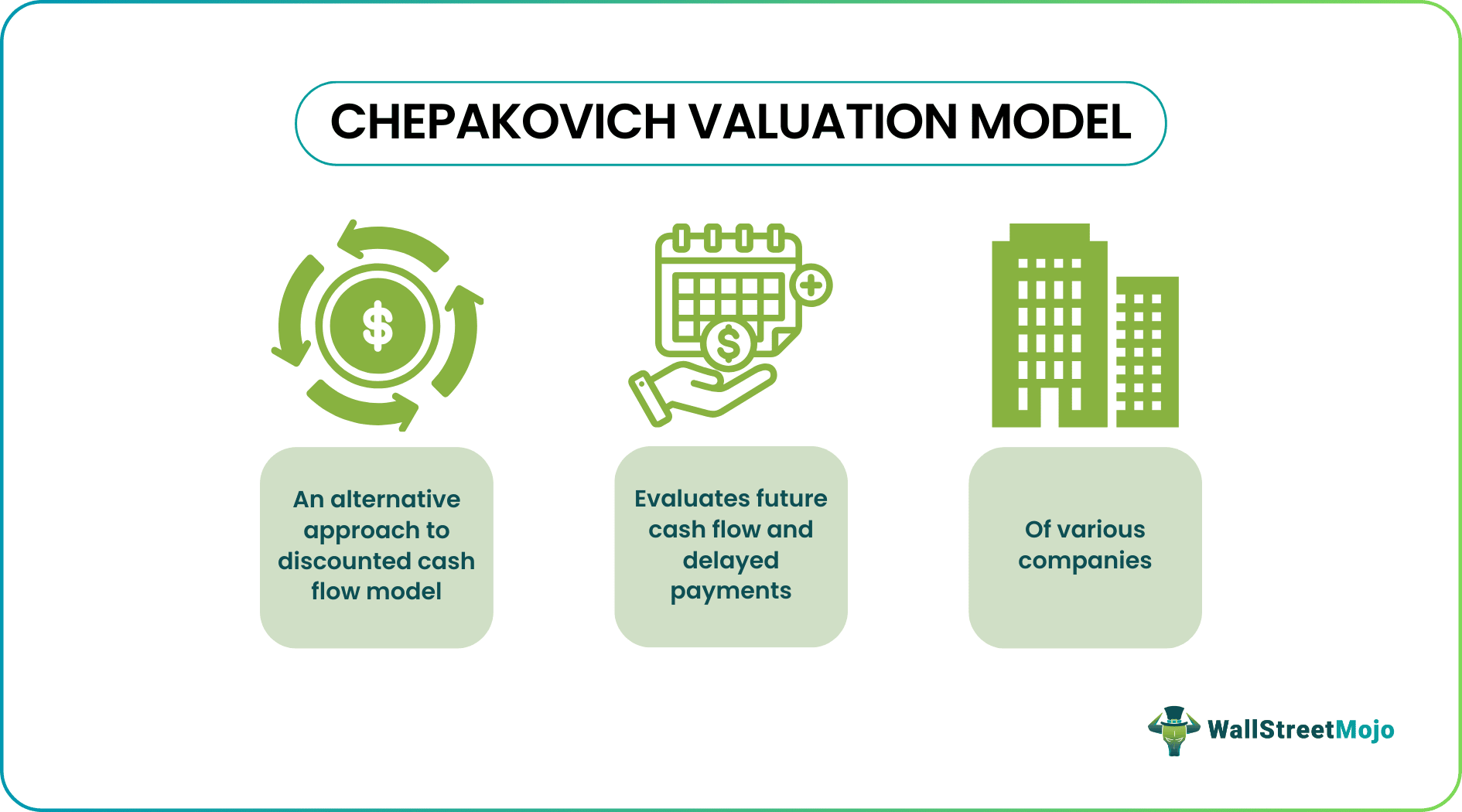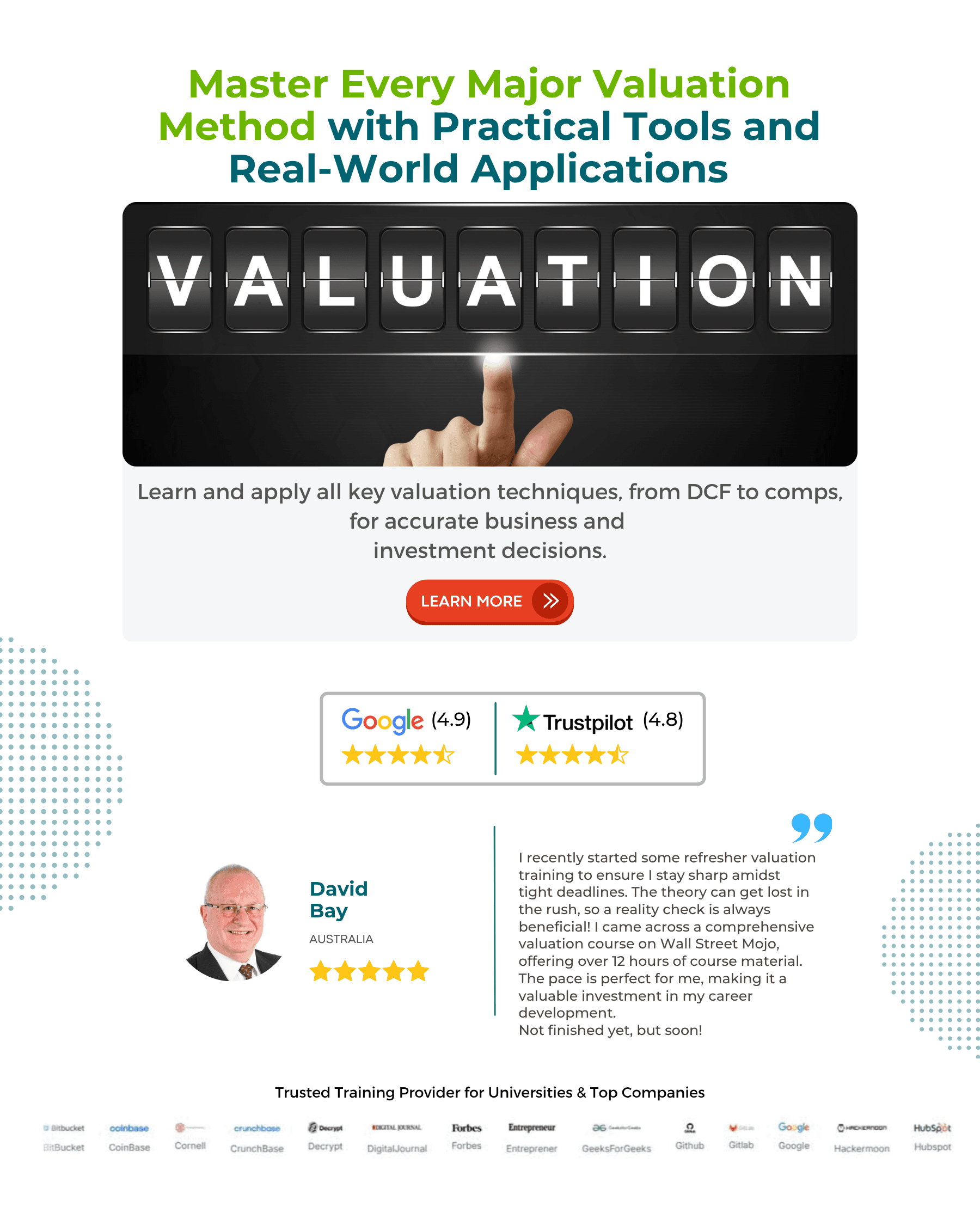Table Of Contents
What Is The Chepakovich Valuation Model?
Chepakovich Valuation Model is used in financial analysis to evaluate the worth of various companies like negative-growth, growth, no-growth enterprises, and growth stocks and start-ups. It serves the goal of estimating the intrinsic value concerning a firm through multiple factors such as risk elements, future cash flows, and growth rates.

It has helped provide segregated predictions related to quasi-fixed costs, fixed assets, and variable costs. Investors and analysts use the distinctive forecasting method of this model to get valuable insights and enable informed investment judgments spread through a broad spectrum of business classes. It is an alternative approach to traditional discounted cash flow (DCF) models and aims to address some of the limitations of DCF.
Key Takeaways
- A Chepakovich valuation model is used in economic research to determine the value of different types of businesses, such as start-ups, growth stocks, and companies with negative or no growth.
- The objective is to calculate the company's intrinsic value using various variables. For instance, including risk components, projected cash flows, and growth rates.
- It offers fundamental value, separate forecasts, variable discount rates, long-term convergence, scenario and sensitivity analysis, cost forecast separation, non-linear relationships, tail risk consideration.
- It assumes non-linear relationships, probability distribution, separate cost forecasts, tail risk consideration, and reliable inputs for meaningful valuations.
Chepakovich's Valuation Model Explained
The Chepakovich Valuation Model is a financial valuation method developed by Alexei Chepakovich. Thus, it constitutes a paradigm for economic valuation that employs non-linear correlations and tail risk analysis, including probability distribution analysis in intrinsically determining a company's value. Moreover, future cash flows, growth rates, and risk components are just a few of the variables the model considers. It sets itself apart by offering different variable, constant, and quasi-fixed expense projections.
Additionally, the Chepakovich valuation model addresses a few limitations of the DCF (Discounted cash flow) model, such as constant or linear cash flow assumptions explained in the Financial Modeling and Valuation Course Bundle. However, this model is particularly helpful in valuing companies with volatile or cyclical cash flows, where the DCF models may need to capture the underlying value accurately.
Pros: Including these elements provides a more precise and adaptable valuation estimate in the Chepakovich valuation model. The Chepakovich Valuation Model more accurately represents complex financial dynamics. Moreover, it gives a thorough risk assessment by considering extreme situations and tail risks. It helps in determining equity duration. Thus, it represents the years it will take for the company's cash flow to cover its market value.
Cons: It depends on comprehensive and precise data inputs, which might be challenging to get for unusual or illiquid assets. Hence, due to assumptions and subjective inputs, the model is inherently subjective, which may impact the accuracy of the results. The choice of parameters can affect the model's outcomes, necessitating careful thought.
In finance, the Chepakovich Valuation Model assesses various assets, including stocks, bonds, derivatives, and real estate. It assists in making investment decisions, evaluating risks, and locating overrated or underappreciated assets. However, its merits in an actual application should be carefully weighed against its complicated structure, data needs, and subjective character.
Features
The Chepakovich Valuation Model is a robust and adaptable framework for examining and appraising a wide range of assets and enterprises thanks to several features presented below:
- Fundamental value: Compared to other valuation methods, it estimates only the actual value instead of the comparative valuation ratios of companies.
- Separate forecasts: These forecasts for a company are quasi-fixed or fixed along with variable expenditures separately.
- Variable discount rate: It utilizes a variable discount rate to represent the required rate of return by investor and their investment risk.
- Long-term convergence: It predicts that a firm's revenue growth rate will eventually converge with an economy's gross domestic product rate.
- Scenario & Sensitivity analysis: It allows users to evaluate the impact of variable changes on valuation outcomes through sensitivity analysis. It also offers scenario analysis to get deep insights into the possible results under various future situations.
- Separation of cost forecasts: It facilitates the analysis of cost components like quasi-fixed and variable costs separately, enabling investors to know the most accurate picture of a business's operational dynamics.
Assumptions
Based on particular modifications or adjustments of the Chepakovich Valuation Model, the assumptions utilized in the model may change. Therefore, let's discuss the various assumptions made in the model as follows:
- Non-Linear Relationships: The model assumes non-linearity amongst variables included in the valuation process. Moreover, it identifies non-linearity exists between inputs and outputs.
- Probability Distribution: The second assumption of the model assumes specific probability distribution of future cash. It does so by considering the span of all outcomes and assigning probabilities to various scenarios.
- Tail Risk Consideration: Fourth, the model explicitly incorporates tail risks and extreme scenarios into the valuation procedure. It does as follows the severe and rare events create a significant effect on the valuation outcome.
- Reliable Inputs for Meaningful Valuations: Lastly, the model assumes that all inputs, like market information and financial data, remain reliable and accurate. Moreover, it depends heavily on the accuracy and quality of such inputs to produce meaningful evaluations.
Examples
Let us look at a couple of examples to understand the topic.
Example #1
Let's assume in the city of Nashville, the capital of the US state of Tennessee, which represents the tech industry, the intrinsic worth of SparkWire was assessed using the Chepakovich Valuation Model. It included non-linear connections and probability distributions to analyze future cash flows, and growth rates, including risk factors.
To enhance analysts' and investors' decision-making in the volatile market, this model helped them decide if SparkWire was overvalued or undervalued.
Example #2
Let's consider Eagle Hill Solution, a Technology company in the US. It has the following inputs:
- Expected free cash flow (FCF) for the next five years:
- Year 1: $10 million
- Year 2: $12 million
- Year 3: $15 million
- Year 4: $18 million
- Year 5: $20 million
- Discount rate 8%:This represents the company's cost of capital.
- Expected long-term growth rate 5%: This is the estimated sustainable growth rate for the company beyond the forecasted period.
- Risk premium 4%: This factor accounts for the additional risk associated with investing in the company.
Based on these inputs, the Chepakovich valuation model would consider the expected cash flows, the discount rate, the long-term growth rate, and the risk premium to determine the present value of future cash flows and estimate the company's intrinsic value.
Thus, the model would discount each future cash flow back to its present value, considering the time value of money and the risk associated with the investment. By summing up the current values of all the cash flows, the Chepakovich valuation model estimates the company's intrinsic value.

